Gates of the Temple Mount
The Temple Mount, located in Jerusalem, can be accessed through eleven gates, and contains a further six sealed gates.
Open gates
The following is an anti-clockwise list of gates which open onto the Temple Mount.
Gate of the Tribes
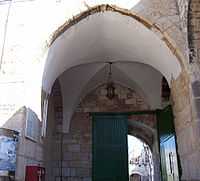
The Gate of the Tribes, (Arabic: Bab al-Asbat), is located at the north-eastern corner of the Temple Mount.
Gate of Remission
The Gate of Remission, (Arabic: Bab al-Huttah), is located on the north side.
Gate of Darkness
The Gate of Darkness, (Arabic: Bab al-Atim), is located on the north side.
Gate of Bani Ghanim
The Gate of Bani Ghanim, (Arabic: Bab al-Ghawanima), is located on the north-western corner.
Council Gate
The Council Gate, (Arabic: Bab al-Majlis; Bab al-Nazer), also known as the Inspector's Gate, is located on the western side.
Iron Gate
The Iron Gate, (Arabic: Bab al-Hadid), Hebrew: Shaar Barzel) is located on the western side, near the Little Western Wall.
Cotton Merchant's Gate
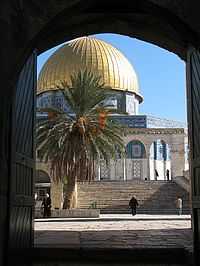
The Cotton Merchant's Gate, (Arabic: Bab al-Qattanin), is one of the most beautiful gates that leads onto the Temple Mount. It was built by Mamluk Sultan ibn Kalaoun. Since this site is the closest a person can get to the Foundation Stone without setting foot on the mount itself, the gate was a popular place of prayer for Jews during the 19th century.
Ablution Gate
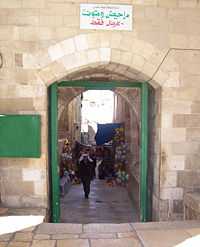
The Ablution Gate, (Arabic: Bab al-Matarah), is located on the western flank.
Tranquility Gate
The Tranquility Gate, (Arabic: Bab al-Salam), is located on the western side.
Chain Gate
The Chain Gate, (Arabic: باب السلسلة, Bab al-Silsileh; Hebrew: Shaar HaShalshelet), located on the western flank may have been the location of the Coponius Gate which existed during the Second Temple period.
Moroccans' Gate
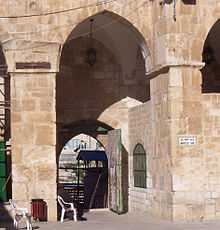
The Moroccans' Gate, Mughrabi Gate,[1][2] or Gate of the Moors, (Arabic: باب المغاربة, Bab al-Magharbeh; Hebrew: Shaar HaMughrabim), is located on the western flank. Over the years, the external façade of Barclay's Gate was covered and the ground outside the Temple Mount was raised many meters above the lintel of the gate. At some stage, probably in the 12th century and maybe even later, a new gate called Bab al-Magharbeh was installed in the Western Wall above the level of the Barclay Gate. It was named after the residents of the adjacent neighborhood, who had come to Jerusalem from Morocco in the days of Saladin. This gate is open to this day and is the only entrance to the Temple Mount for non-Muslims.[1][2]
The gate, specifically the excavation of the historic ramp leading up to it, has been a point of contention between Israelis and Arab Muslims.[3] In February 2004, an 800 year-old wall holding back part of the hill jutting out from the Western Wall leading up to the Mughrabi Gate partially collapsed. Israeli authorities believed a recent earthquake and/or snowstorm may have been responsible while Muslim officials attributed the collapse to Israelis working in the area.[4][5] In 2007, the Israel Antiquities Authority started work on the construction of a temporary wooden pedestrian pathway to the Temple Mount called Mughrabi-Bridge.
Sealed gates
The wall surrounding the Temple Mount contains six sealed gates:
Golden Gate

The Golden Gate, (Arabic: Bab al-Zahabi), (Hebrew: Sha'ar Harachamim), located on the eastern wall of the Temple Mount was probably built in the 520s CE, as part of Justinian I's building program in Jerusalem, on top of the ruins of an earlier gate in the wall. An alternate theory holds that it was built in the later part of the 7th century by Byzantine artisans employed by the Umayyad khalifs. It has two vaulted halls which lead to the Door of Mercy, Bab al-Rahma, and the Door of Repentance, Bab al-Taubah.
Single Gate
The Single Gate is located along the southern wall. It once led to the underground area of the Temple Mount known as Solomon's Stables.
Huldah Gates
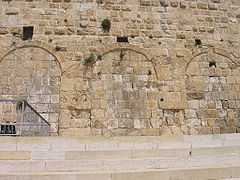
The Huldah Gates (Arabic: Bab al-Thulathe) comprise two sets of bricked-up gates in the southern wall of the Temple Mount. The left set is a double-arched gate, known as the Double Gate. This gate is blocked from vision by a crusader tower and only part of the right gate can be seen. The only original part of the gate still visible is the lintel and even this is no longer in its original position. When first laid it was 11 metres above the doorstep.
The set on the right is a triple-arched gate, known as the Triple Gate. Each of the gates once led into an aisle of a passageway leading from the gate into the Mount, and to steps leading to the Mount's surface.
The fact that the original entrance gateways still exist reflects an ancient promise cited in Shir ha-Shirim Rabbah: "The Kohen Gate and the Huldah Gate were never destroyed and God will renew them".
Barclay's Gate
Barclay's Gate lies under the Moroccans' Gate and is one of the Temple Mount's original gates. It is named after James Turner Barclay who was a Christian missionary in Jerusalem in the mid-19th century. He discovered it from its inner side, within the Temple Mount, in 1852. The discovery of the gate led several researchers to identify it as one of the Temple Mount gates, possibly the Coponius’ Gate, which dates back to the Second Temple and are mentioned in Jewish and Christian sources of the period. The gate was blocked with stones at the end of the 10th century and the gate room on the internal side was devoted to Buraq. Today the room is closed and entrance to it is prohibited without the approval of the Waqf.[6]
After the Six-Day War, the Israel Religious Affairs Ministry and the dig conducted below the southern wall of the Temple Mount by Prof. Binyamin Mazar, planned to uncover this gate but they were prevented from doing so by both Jewish and Muslim religious leaders.[7]
Warren's Gate
References
| Wikimedia Commons has media related to Gates of the Temple Mount. |
- ↑ 1.0 1.1 "Tourism Min. plan to widen Jewish access to Temple Mount angers Palestinians". Haaretz. 7 October 2014. Retrieved 5 November 2014.
- ↑ 2.0 2.1 "Israel issues tender for new settlement units". Al Jazeera. 18 December 2011. Retrieved 5 November 2014.
- ↑ Marshall J. Breger; Yitzhak Reiter; Leonard Hammer (19 June 2013). Sacred Space in Israel and Palestine: Religion and Politics. Routledge. pp. 251, 266. ISBN 978-1-136-49034-7.
- ↑ BBC NEWS. Warning over Jerusalem holy site
- ↑ Jerusalem wall collapse sparks Jewish-Muslim row
- ↑ Baruch, Yuval. "The Mughrabi Gate Access - The Real Story". Israel Antiquities Authority. Retrieved 2007-07-10.
- ↑ Shragai, Nadav (February 12, 2007). "The gate of the Jews". Haaretz. Retrieved 2007-07-10.